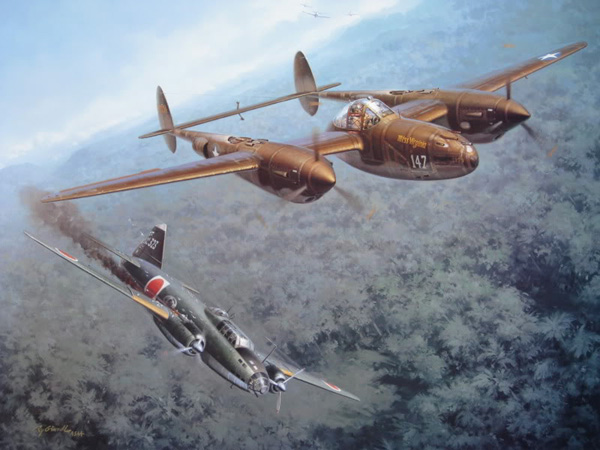
A recent post from my LOCKHEED P-38 LIGHTNING collection. Artwork portraying the P-38 Lightning’s most famous mission of WWII.
From the web-site:
U.S. naval intelligence had intercepted and decrypted messages that Yamamoto would be flying from Rabaul to Balalae Airfield, near Bougainville in the Solomon Islands to perform a troop inspection and raise morale after the evacuation of Guadalcanal. Yamamoto was noted for being punctual and this allowed the Lightnings to precisely coordinate their attack on Yamamoto and his staff, flying in two G4M1 Betty bombers escorted by six Zeroes.
A squadron of eighteen P-38s, led by Major John W. Mitchell of the 339th Fighter Squadron on April 18, 1943 were assigned to the mission. A “kill” flight of four airplanes was assigned to intercept Yamamoto’s plane that consisted of Tom Lanphier, Rex Barber, James McLanahan and Joseph Moore. The other P-38s would provide top cover at 18,000 ft (5,485 m).
On the way out, McLanahan’s plane blew a tire and Moore’s drop tanks wouldn’t feed fuel to the engine, so they were replaced by Raymond Hine and Besby Holmes. The squadron now consisted of 16 planes and they headed for New Georgia, flying only thirty feet (9 m) above the water to avoid detection by the Japanese. Flying at low altitude above a calm sea, the cockpits became very hot and uncomfortable and one pilot almost dozed off as his props hit the water spraying water onto his cockpit canopy. Startled, he quickly woke up and remained alert for the rest of the flight and was so frightened that he had trouble sleeping the next few days.
The P-38s arrived only one minute before Yamamoto’s plane arrived at the interception point. As the P-38s approached Bouganville, they dropped their tanks and began climbing. It wasn’t long before they spotted their target. The two Betty bombers were flying at 4,500 ft. (1,370 m) and descending, escorted by the six Zeroes flying 1,500 ft. (457 m) above and behind each side of the bombers.
The kill team headed for the bombers, but Holmes’ tanks wouldn’t release and he pealed off, followed by his wingman Hine. The rest of the squadron climbed to 18,000 ft. (5,485 m) as top cover. Realizing they were spotted, the bombers headed for the deck and were pursued by the two remaining kill pilots, Rex Barber and Tom Lanphier. The escorting Zeroes headed straight for the attacking P-38s. Lanphier turned into the attacking Zeroes and claimed one kill. Barber headed for the bombers and fired into Yamamoto’s G4M1 Betty.6 One engine started emitting black smoke and then flames streamed from the bomber. Lanphier then claimed to have turned into Yamamoto’s bomber and fired a deflection shot from a right angle. Yamamoto’s plane crashed into the jungle and the remaining Betty carrying Admiral Ugaki was chased by Barber and Holmes over the water. The second bomber was shot down and it went down into the sea at full speed. Although the Americans claimed to have shot down four Zeroes, all six returned to base at Rabaul. The only P-38 that did not return was flown by Raymond Hine. Tokyo did not admit the loss of Yamamoto until May 21, 1943.7
There was a long simmering debate as to who actually shot down Yamamoto’s airplane. When the mission arrived back at base, Tom Lanphier immediately laid claim to shooting down Yamamoto’s plane and he was given official credit. Rex Barber disputed the official report and both pilots were given half credit. There were no gun cameras and no official debriefing at the end of the mission, so the true account of what actually transpired that day has never been fully resolved.
Originally shared by Pete Panozzo
The attack on Admiral Yamamoto was the P-38’s most famous mission.




Recent Comments